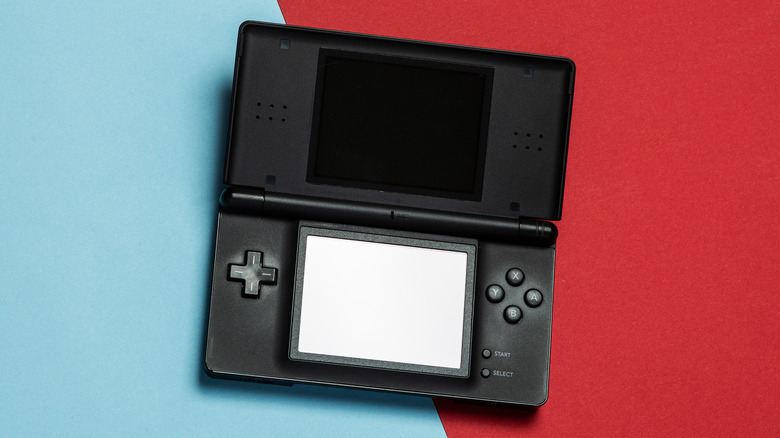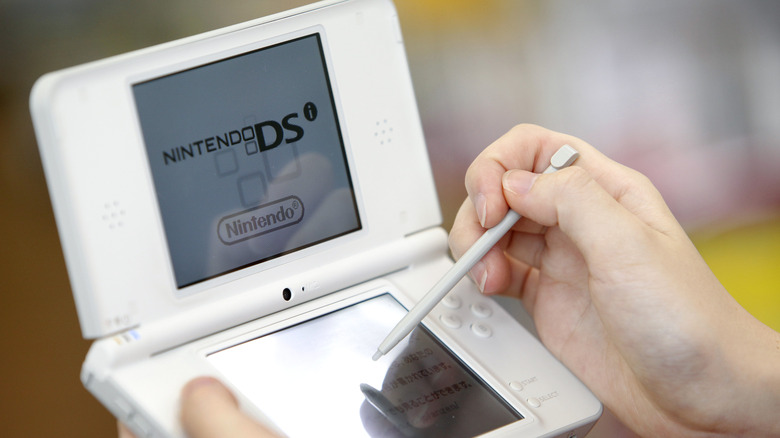Web Browsing On The Nintendo DS: Why It Flopped
The original Nintendo DS was a lovely little handheld console in its heyday, with plenty of fun games to play and nifty features to use. That said, Nintendo has always been a bit slow on the uptake when it comes to changing industry standards, and nowhere was this clearer than with the online features on the DS. The DS' Pictochat, for instance, could only be used over local wireless signals, and while some games like "Mario Kart 7" did have online support, it was a bit on the spotty side.
Nintendo's relationship with online functionality is known for being a bit roughshod, even well into the era where online integration was becoming the norm. Still, the DS was popular enough to warrant the effort from developers, which is why Nintendo took a swing at giving it a dedicated web browser. Did it work? Well, you read the title here, so you can probably guess.
What was the Nintendo DS Browser?
In 2006, the Opera Software Company, developer of the Opera web browser, announced that it would be developing a standalone version of its browser for use on the Nintendo DS and DS Lite handhelds with Nintendo's blessing. In the summer of that year, the browser was released in Japan, followed by releases in the EU, Australia, and North America, in that order.
The DS Browser was released as a dual-cartridge system; one regular DS cartridge in the system's primary slot, and an expansion pack slotted into the Game Boy Advance cartridge slot. With both cartridges slotted, the DS could then connect to the internet at large through a Wi-Fi hotspot, though it could only connect to a WEP network or a network with no password protection. WPA-encrypted networks were not supported at all.
Once you were online, you could browse the 'net as you normally would. You could display a single page on both of the DS' screens, use just one of the screens, zoom in with the stylus, and more. If you wanted to type something, you could use a digital keyboard on the touchscreen, or draw the letters and words you wanted to write with the stylus.
What went wrong?
In the mid-2000s, the idea of browsing the full internet on a mobile device was still very young. Even cell phones couldn't manage such a feat, and the DS didn't fare much better. For one thing, even with the memory boost from the expansion pack, the DS simply didn't have enough onboard memory to handle the dynamic aspects of browsing. Images loaded very slowly if at all, sounds and video were prone to failure, and while the browser did support JavaScript and SSL, it couldn't render any Flash objects.
A large portion of the internet was Flash-reliant back then, which meant you couldn't see any of it. Additionally, due to the lack of WPA support, which was in fairly common use at the time, browsing with the DS wasn't very secure. Entered data was unencrypted, which meant it was easier for bad actors to steal. The only notable security feature the browser came with was a parental filter that automatically blocked access to certain websites.
The DS Browser's legacy
In 2007, after only a few months on the market and less-than-stellar reception, the DS Browser was discontinued in North America. Even if it hadn't been, it would've been swiftly rendered obsolete by the release of the Nintendo DSi a year later, which featured native internet browsing support (and didn't have a Game Boy Advance slot, so it couldn't use the required expansion pack anyway).
Nintendo tinkered with the idea of built-in web browsers on its consoles and handhelds for several generations, giving the function to the Nintendo Wii, Wii U, and 3DS with varying levels of success. As of the release of the Nintendo Switch, though, the company has stopped adding native browsing functionality. Compared to the mid-2000s, Nintendo's internet connection features are definitely much better now, so if it ever felt so inclined, it could probably give the web browser another try on the Switch or a future console. Of course, everyone has a smartphone these days that can browse on par with a full PC, so it may not be worth the time and resource investment.



